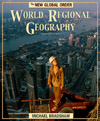 |  World Regional Geography: The New Global Order Update, 2/e Michael Bradshaw,
College of St. Mark and John
Eastern Asia
Chapter ObjectivesAfter reading and studying this chapter you should be able to:
| 1. Understand that levels of development vary from poor Cambodia to
wealthy Japan. |
 |  |  | | 2. Know that in Eastern Asia one third of the world's population lives on
about one tenth of the world's land. |
 |  |  | | 3. Know the Asian "tigers" and that they have almost completed the
transition from the periphery to the core. |
 |  |  | | 4. Outline the various ways that the European powers impacted the
countries of Eastern Asia. |
 |  |  | | 5. List the important climatic environments of Eastern Asia. |
 |  |  | | 6. Discuss the management issues associated with the Mekong River. |
 |  |  | | 7. Locate the Spratly Islands and explain their possible significance. |
 |  |  | | 8. Describe the characteristics of the four main islands of Japan. |
 |  |  | | 9. List the factors and conditions that contributed to the growth of
Japanese manufacturing. |
 |  |  | | 10. Describe the transformation of South Korea into one of the Asian
tigers. |
 |  |  | | 11. Differentiate economic development in China with economic
development in Japan. |
 |  |  | | 12. Discuss the changing roles of China within Eastern Asia. |
 |  |  | | 13. Compare and contrast the "Great Leap Forward" and the "Cultural
Revolution" of China. |
 |  |  | | 14. Describe population control efforts and results in China. |
 |  |  | | 15. Compare and contrast Mongolia and North Korea. |
 |  |  | | 16. Understand Chinese and Japanese influences on Southeastern Asia. |
 |  |  | | 17. Differentiate urbanization trends in most of Southeastern Asia from
deurbanization policies in Vietnam. |
 |  |  | | 18. Describe Singapore's successful economic development. |
 |  |  | | 19. Explain the global significance of the rapid economic growth found in
many areas of Eastern Asia. |
 |  |  | | 20. Examine the role of the Association of Southeast Asian Nations
(ASEAN) in the future of Eastern Asia. |
 |  |  | | 21. Understand why and how economic growth in parts of Eastern Asia
has been interrupted in the late 1990s. |
|



 2002 McGraw-Hill Higher Education
2002 McGraw-Hill Higher Education